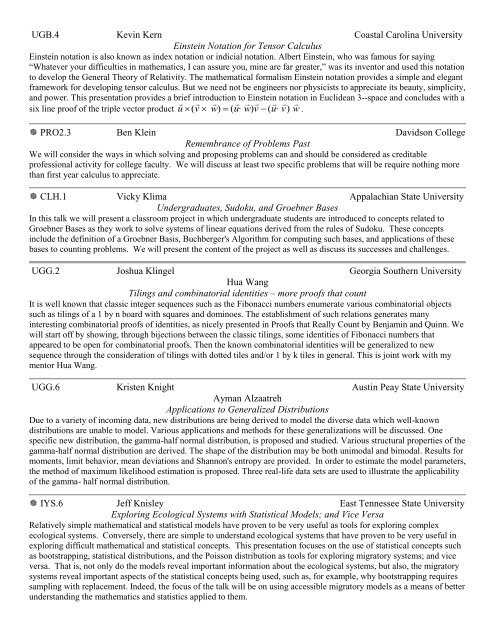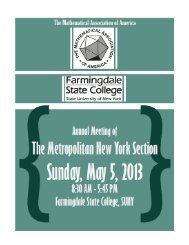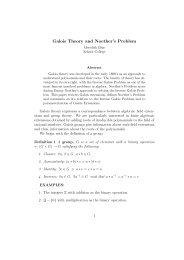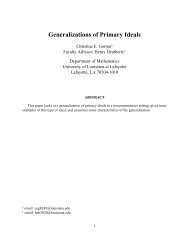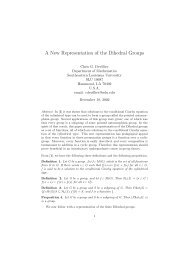Presentation Abstracts - MAA Sections
Presentation Abstracts - MAA Sections
Presentation Abstracts - MAA Sections
Create successful ePaper yourself
Turn your PDF publications into a flip-book with our unique Google optimized e-Paper software.
UGB.4 Kevin Kern Coastal Carolina University<br />
Einstein Notation for Tensor Calculus<br />
Einstein notation is also known as index notation or indicial notation. Albert Einstein, who was famous for saying<br />
“Whatever your difficulties in mathematics, I can assure you, mine are far greater,” was its inventor and used this notation<br />
to develop the General Theory of Relativity. The mathematical formalism Einstein notation provides a simple and elegant<br />
framework for developing tensor calculus. But we need not be engineers nor physicists to appreciate its beauty, simplicity,<br />
and power. This presentation provides a brief introduction to Einstein notation in Euclidean 3--space and concludes with a<br />
six line proof of the triple vector product u ( v w) ( u· w) v ( u· v)<br />
w .<br />
PRO2.3 Ben Klein Davidson College<br />
Remembrance of Problems Past<br />
We will consider the ways in which solving and proposing problems can and should be considered as creditable<br />
professional activity for college faculty. We will discuss at least two specific problems that will be require nothing more<br />
than first year calculus to appreciate.<br />
CLH.1 Vicky Klima Appalachian State University<br />
Undergraduates, Sudoku, and Groebner Bases<br />
In this talk we will present a classroom project in which undergraduate students are introduced to concepts related to<br />
Groebner Bases as they work to solve systems of linear equations derived from the rules of Sudoku. These concepts<br />
include the definition of a Groebner Basis, Buchberger's Algorithm for computing such bases, and applications of these<br />
bases to counting problems. We will present the content of the project as well as discuss its successes and challenges.<br />
UGG.2 Joshua Klingel Georgia Southern University<br />
Hua Wang<br />
Tilings and combinatorial identities – more proofs that count<br />
It is well known that classic integer sequences such as the Fibonacci numbers enumerate various combinatorial objects<br />
such as tilings of a 1 by n board with squares and dominoes. The establishment of such relations generates many<br />
interesting combinatorial proofs of identities, as nicely presented in Proofs that Really Count by Benjamin and Quinn. We<br />
will start off by showing, through bijections between the classic tilings, some identities of Fibonacci numbers that<br />
appeared to be open for combinatorial proofs. Then the known combinatorial identities will be generalized to new<br />
sequence through the consideration of tilings with dotted tiles and/or 1 by k tiles in general. This is joint work with my<br />
mentor Hua Wang.<br />
UGG.6 Kristen Knight Austin Peay State University<br />
Ayman Alzaatreh<br />
Applications to Generalized Distributions<br />
Due to a variety of incoming data, new distributions are being derived to model the diverse data which well-known<br />
distributions are unable to model. Various applications and methods for these generalizations will be discussed. One<br />
specific new distribution, the gamma-half normal distribution, is proposed and studied. Various structural properties of the<br />
gamma-half normal distribution are derived. The shape of the distribution may be both unimodal and bimodal. Results for<br />
moments, limit behavior, mean deviations and Shannon's entropy are provided. In order to estimate the model parameters,<br />
the method of maximum likelihood estimation is proposed. Three real-life data sets are used to illustrate the applicability<br />
of the gamma- half normal distribution.<br />
IYS.6 Jeff Knisley East Tennessee State University<br />
Exploring Ecological Systems with Statistical Models; and Vice Versa<br />
Relatively simple mathematical and statistical models have proven to be very useful as tools for exploring complex<br />
ecological systems. Conversely, there are simple to understand ecological systems that have proven to be very useful in<br />
exploring difficult mathematical and statistical concepts. This presentation focuses on the use of statistical concepts such<br />
as bootstrapping, statistical distributions, and the Poisson distribution as tools for exploring migratory systems; and vice<br />
versa. That is, not only do the models reveal important information about the ecological systems, but also, the migratory<br />
systems reveal important aspects of the statistical concepts being used, such as, for example, why bootstrapping requires<br />
sampling with replacement. Indeed, the focus of the talk will be on using accessible migratory models as a means of better<br />
understanding the mathematics and statistics applied to them.


